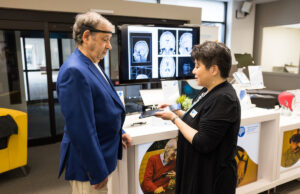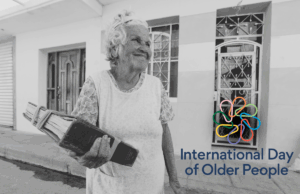You could say that Adelina Comas-Herrera sees the “big picture” when it comes to long-term care. She is director of the Global Observatory of Long-Term Care (GOLTC), a platform designed to facilitate cross-national learning to improve and strengthen long-term care systems worldwide, where researchers, policymakers, and care providers share their work and collaborate. Comas-Herrera is based at the Care Policy and Evaluation Centre at the London School of Economics and Political Science (LSE); LSE is home to GOLTC’s parent organization, the International Long-Term Care Policy Network (ILPN).
GOLTC was launched in late 2024, inspired by a previous platform Comas-Herrera directed, LTCcovid.org, that shared data on the pandemic’s effects on older adults and the long-term care sector internationally.

That “massive collaboration of experts,” she said, demonstrated “that a lot of the problems with the COVID pandemic in the long-term care sector [were] to do with structural issues that were common across many countries,” and led to the creation of GOLTC.
GOLTC has grown to more than 655 members—researchers, care providers, and policymakers—and “benefits from people’s willingness to share their work and to learn from each other,” said Comas-Herrera. It includes 26 interest groups on a variety of topics, from health in aged care to long-term care policy, workforce, technology, and more. The groups are created and organized from the bottom up by members who own the topics, with support from GOLTC’s small staff. The platform is also home to 17 long-term care country profiles, with Zimbabwe and Malta in draft form to be published soon. Comas-Herrera said a new part of the observatory is also under development to compare aspects of care covered by public systems in different countries.
Global Ageing Network asked Comas-Herrera to share what she’s learned about aged care worldwide in GOLTC’s first year.
Global Ageing Network: From your perspective on worldwide research in the long-term care field, what are the most compelling areas of inquiry today?
Adelina Comas-Herrera: “We now have a lot of data. There are some interesting studies with sophisticated methods enabling us to understand things in the longer term. For example, if somebody is providing care to a relative for many years, we’re now able to look through longitudinal databases of what’s happening and how that’s impacting say, women who give up their jobs and then try to return to work. We’re able to understand a lot more [about] the consequences of leaving care to the family. We’re also able to measure outcomes better.”
Global Ageing Network: What about the use of technology and the effect of artificial intelligence (AI) on aged care?
Adelina Comas-Herrera: “There is surprisingly little research on that. There is a lot of investment in development of technology, and quite a bit of research on acceptability of technology, but we have very little on the outcomes, and what difference it makes to people in their daily lives or, for example, whether it’s cost-effective. It’s great that we’re beginning to see AI used in tangible ways that make a difference in long-term care.”
Global Aging Network: The long-term care workforce is a major issue that our members worldwide struggle with. What trends do you see in that research, especially about attracting and training young people to build careers in long-term care?
Adelina Comas-Herrera: “We see many countries rely on international migration, but [there are] all sorts of complications when it comes to language [and] cultural barriers. In terms of why it is so difficult to attract people to work in this sector, to me, adequate financing is the key. It enables better pay and the working conditions that go alongside it. If you don’t support people, working in this sector can be very stressful and very difficult. But it is a job that can also be absolutely beautiful, and it can be extremely rewarding if done in the right conditions. This is telling us that we are maybe not spending enough on care to get the quality of jobs, [and] also the quality of care that we want.”
Global Aging Network: In your opinion, what could spur more investment from governments in care for the aged population?
Adelina Comas-Herrera: “My initial research was on projections of future expenditure on long-term care as a result of population ageing, almost 30 years ago. The projections didn’t become true because of two reasons: First is that expenditures didn’t go up in line with the ageing of the population, and the second is [that] we haven’t aged in the way we thought. People are actually living quite a few more years in good health, and we hadn’t fully understood 25 years ago that this was going to happen. And in my view, we have always been a bit scared about public investment in long-term care because of a fear of the implications of demography. But more and more, we understand the costs of inaction and the fact that the more we catastrophize about care and about the need to put more money in, the less likely it is that we will see actual investment. We need to be able to explain what is good about investing in care, what difference it makes and why it is worth it. I hope that the kind of work we do and the alliances we can build … will help change this negative narrative.”
Global Ageing Network: What do you think is the best positive argument to policymakers for that kind of investment?
Adelina Comas-Herrera: “A country that fascinates me is Denmark. I know it’s very small, but they spend three percent of GDP [gross domestic product] on the public long-term care system and I can’t see that that country is going bankrupt as a result of spending more than double on care as a share of GDP than most of the other countries. And we need to understand that even when we look at GDP and how much care is as a share of GDP, what we see is not a cost, but it’s the economic value that the sector is generating. And it’s one of the areas of employment where jobs will not disappear due to automation. Robots are not going to take over; we will benefit from technology, but that doesn’t mean we will not need humans.”






